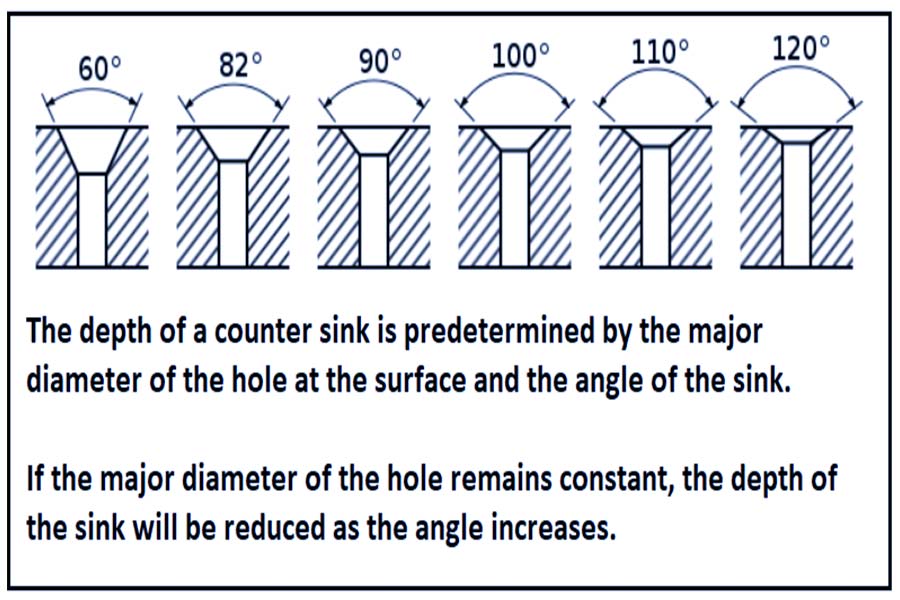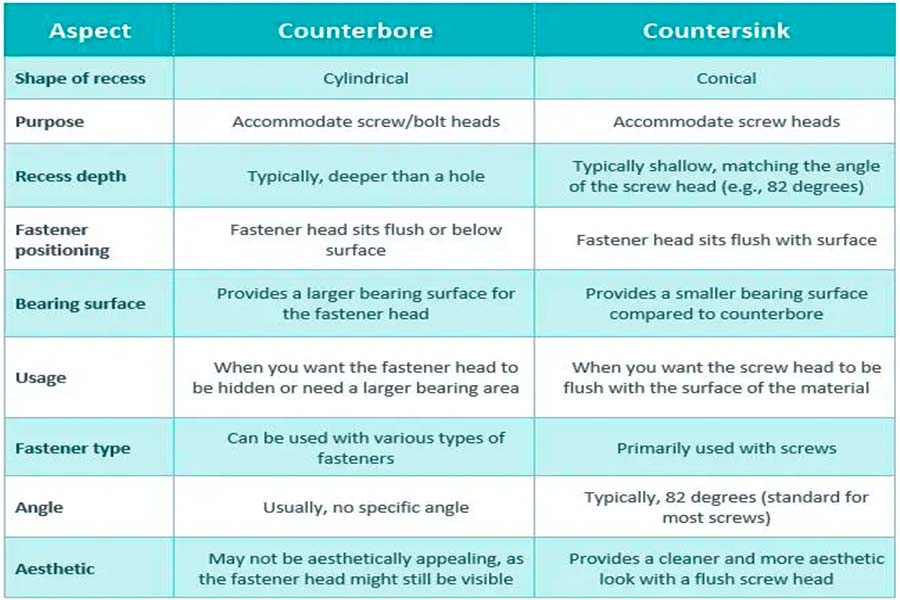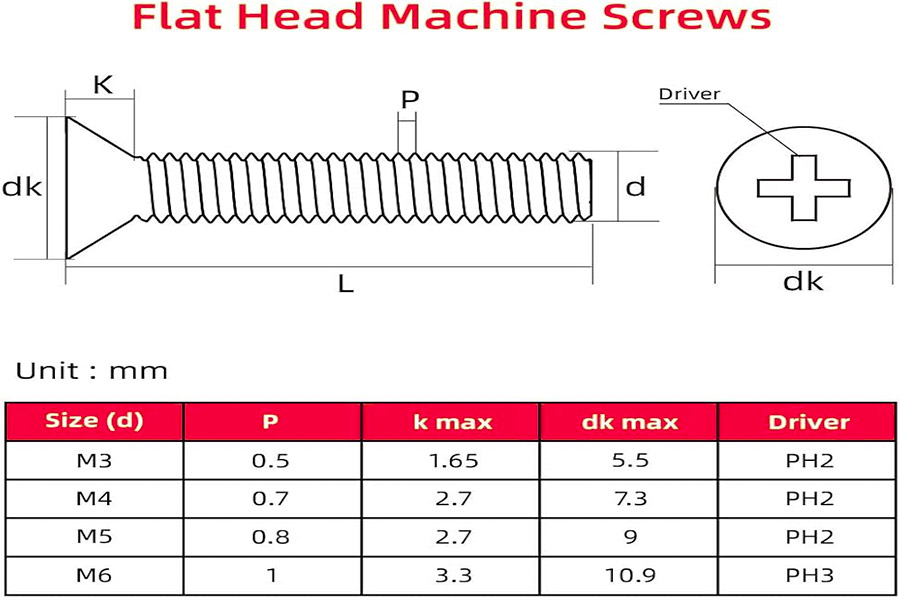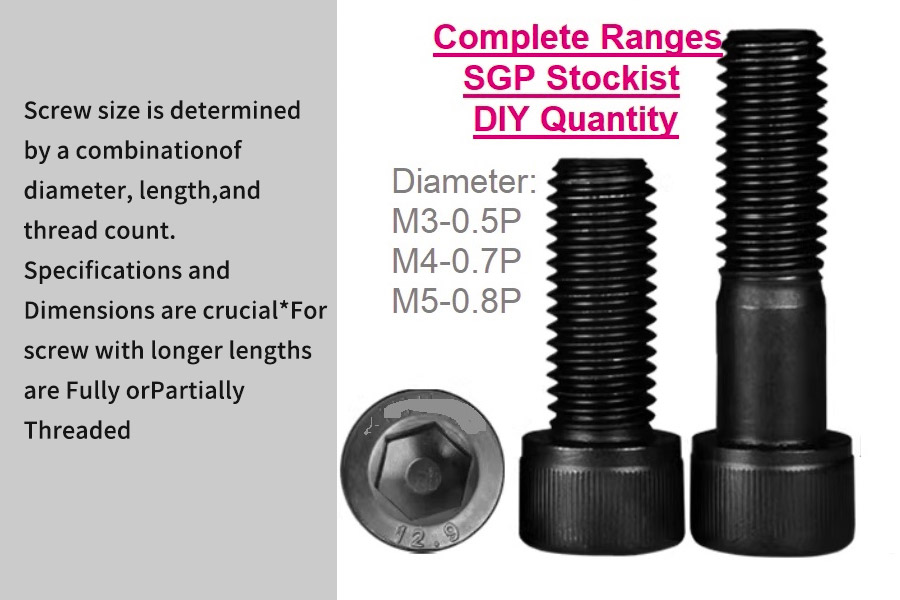Imagine: Two pieces you carefully designed won't fit together because of a head-high protruding screw. Or, a key bolt has suboptimal load-carrying capacity or even premature failure because the bottom surface isn't supported. These aches and pains tend to result from an easy choice -do Icountersink or counterbore?
They both are so designed that the head of the bolt or screw can be "hidden" under the surface of the material, both beautiful and handy. But don't mix them!
- The counterboreis a funnel-type, conical (often 82° and 90° angles), particularly with flat head screws, so that the screw head can be easily sunk.
- The countersinkis a conical step hole with a flat bottom and straight sidewalls that provides a solid support plane to the bolt head, washer or nut.
You can't choose which one you want. Counterbore are efficient in processing thin plates and woodworking, and they are quick to install. The countersink hole has a flat bottom structure and a larger pressure-bearing area, which is more advantageous in situations where higher loads need to be borne and bolts with nuts or washers are used (e.g.,automotive structuralcomponents and chassis connection).
In our actual operation, we must make a comprehensive judgment on the material, stress conditions, and the type of screws used, and choose the most suitable hole type, so that the things are strong, easy to use, and look professional.
Summary Of The Core Answer:
| Feature | Countersink | Counterbore |
| Shape | Conical shape/horn mouth. | Flat Bottom Cylinder. |
| Purpose | Make the head of the flat head/cone head screw flush with or below the surface. | Fully accommodate the head of the hexagon socket/hexagon socket bolt in the hole. |
| Mating Fastener | Flat Head Screw. | Socket Head Cap Screw. |
| Engineering Drawing Symbol | ∨ | ⌴ |
This article will answer your questions:
- This guide will fundamentally clarify the difference between countersink holes and counterbore holes, and help you understand how to read and use their symbols on drawings.
- We will use a real example of "precision instrument" to see how these two types of holes perform their respective functions in the same product.
- Finally, we will also explain clearly the issues you care about, such as how much angle to choose and how deep to set, so that you can choose and use them correctly during design and processing.
Why Should You Trust This Guide? JS's Experience In Processing Millions Of Holes
In our JS company, what we deal with most every day areCNC machining partswith various precision holes. The authority of this guide is rooted in our deep experience insolving practical engineering problems:We have made thousands of countersinks that require mirror-level flatness for aircraft parts, and we have also processed counterbores for heavy equipment that have to withstand huge bolt tension.
What is the difference between 82° countersinks and 90° countersinks?
If the counterbore depth is slightly different or the diameter is slightly off, will it get stuck during assembly? We know these details too well. When our engineers get the customer's drawings, the first thing they do is to confirm the symbols of countersinks and counterbores and the selected screws and bolts can perfectly match each other, which is the first line of defense to avoid assembly failure.
The things in this guide are not made up out of thin air. It strictly follows the mechanicaldesign standards (GD&T), and is the real experience we have accumulated bit by bit in the workshop and on the assembly line over the years. It combines the requirements of international standards and our engineering judgment verified by practice.
"Accuracy is the soul of manufacturing, as emphasized by Sir Joseph Whitworth, a pioneer in the field of precision engineering. "
This sentence deeply explains our attitude towards every hole feature. The knowledge conveyed in this guide is the embodiment of this engineering spirit of pursuing precision and reliability, and it is the foundation for us to help you lay the foundation for successful manufacturing and long-term operation during the design stage.
In-Depth Analysis: "Identity Profiles" Of Two Hole Features
I often encounter the choice of countersink and counterbore in daily design. Now, I'll compare the "identity profiles" of these two kinds of holes.Not only are they different in form, but also each has a particular function.This can help you choose the right tool and avoid holding up your project.
Countersink: Quest for smoothness and streamline
Definition:Countersink is an enlarging conical feature that forms precise conical clearance space for cone-head screws (e.g. 82° aircraft screws, 90° ISO screws) to create a zero-raised surface. In helicopter rotor parts, 0.1mm screw protrusion can contribute 15% to aerodynamic noise.
What is the main purpose of it?
Particularly matched with flat-head or tapered screw heads. Its major purpose is to allow the screw head to be in flush and ultimately be completely level with the surface of the part. Think about it, theairplane casing, parts that need to reduce wind resistance, or places where you don't want to scratch your hands, can't have a screw head sticking out, right?This depends on countersink.
Major tools:Our main use is countersink drill bits use, this drill bit is not a random taper, and there are standard angles! The most common are 82° (commonly used in North America) and 90° (ISO standard, more popular in JS and abroad). The tool cost is low, easy to replace, suitable for manual or CNC processing.
Drawing marking:Put a ∨ symbol on the drawing, and the key angle and maximum diameter (i.e., the diameter at which the screw head can be completely buried) will be shown clearly beside it. For example: "Ø10 ∨ 90°" means to produce a 90° countersink with a maximum taper diameter of 10mm.
Counterbore: For strength and concealment
Definition:A counterbore is a deep cylindrical depression, and a larger cylindrical "hole" is "dug" on the central hole to accommodate the bolt head, nut or washer, hiding them under the surface. The purpose is to improve the appearance, and more significantly, to give the bolt a flat bottom support surface.
Main purpose:This is the section carved out for the bolt head, nut or washer. It is not just for aesthetics, its ultimate goal is to allow the head of the bolt to be in this recessed flat bottom hole. This way, you can evenly apply the force on the entire contact area when you screw the bolt in order to achieve the highest clamping force.Heavy equipmentand highly loaded structural parts need this kind of force the most.
Key tools:We can use a specially counterbore drill, but when we process by CNC, we can directly use an end mill to process straight, and drilling speed control is the key.
How to reflect it on the drawing?
There is a ⌴ symbol on the drawing.The depth and size of this "pit" must be marked clearly. For example:Ø15 ⌴ 5, which means making a flat-bottomed countersink with a diameter of 15mm and a depth of 5mm.
Tips: The difference between them and counterdrill
That name is no longer used these days. It previously referred to all forms of predrilling a larger hole above the original hole, without specifying whether it is flat-bottomed or not. Nowadays we have more particular names such as countersink and counterbore for specificCNC machining, and even the drawings should be specifically marked unambiguously.
As regards countersink angle tolerance (a highly critical matter too many times left out)
Angle tolerance has a significant influence upon countersink operation (especially flushness), but is too many times oversimplified.
| Nominal sinkhole angle | Angle tolerance | The impact on screw alignment |
| 82° | ±1° | A deviation of ± 1° may cause the screw head to protrude or recess by 0.1-0.3mm (depending on the screw size), affecting aerodynamics or causing interference. |
| 90° | ±1° | As mentioned above, improper tolerance control can easily lead to uneven assembly or stress concentration. |
| 100° / 120° | ±2° | When the angle is larger, the tolerance is usually relaxed, but specific application requirements still need to be considered. |
Data source: ASME B94.11M-1993 - Twist Drills.
Countersinking requiressmooth surfaceand precise angles. Counterbore requires reliable load bearing, and the key lies in flat bottom and depth. Which one to choose depends on your screw type and assembly requirements. Next time you draw, pay attention to the symbols ⌴ and ∨, and mark the full size tolerance!
"As an engineer, I suggest starting the test project from a standardized perspective first. If you are not sure, talk to my JS company and we will help you customize the solution to optimize efficiency. Choose the right hole feature to get the design spot on first time!"

Decision Framework: Countersink vs. Counterbore, How To Choose?
First principle: The screw has the final say!
This is the simplest and most critical one. Look at the shape of your screw or bolt head:
- To process flat-head or pointed-head screws, you must use countersinks. The conical pit produced by countersinking just matches the head of this screw.
- The hexagon socket head or hexagon socket bolt must becounterbored. The flat step produced by the counterboring provides a complete support plane for the bolt head.
Why is it so absolute?
The precise matching of the hole type and the screw head type is the only way to ensure the maximum contact area and effectively transmit the tightening force. If it is wrong, the screw head or bolt head cannot fit the hole completely, the contact surface is very small, and it cannot provide enough tightening force at all. This is a safety hazard that must be eliminated in engineering design.
The second principle: decide based on genuine needs.
On the basis of meeting the first point, look at the specific application scenario:
- Do you need an absolutely flat and smooth surface?For example, instrument housing, panel (to prevent hooking clothes), or fluid needs to pass smoothly through the surface. At this time, countersinking is the first choice, because the screw head can sink and be flush with the surface.
- Do you need an extremely large clamping force?For example, joining the engine cylinder head flange and heavy machinery. Counterbore is the only choice in such a situation. It provides a perfect large-area horizontalbearing surfacefor the bolt head that can attain maximum load-carrying capacity.
- Do you require hiding the bolt head in a confined area?For example, inside a small mechanical assembly. Counterbore can be extended deeper, so that the entire bolt head is "hidden" inside the hole and won't protrude from the surface.
Third principle: Material thickness determines feasibility.
- Thin material plate (such as sheet metal): Countersinking is often the only feasible or safest option (or similar countersunk made bystamping). Counterbore thin plates will take away too much material, greatly weaken the workpiece, and is unsafe.
- Thick pieces: Both countersinking and counterbore can be seen as technical. Now the choice returns to the two principles established earlier: think about the screw type and application requirements.
"At JS, when making design decisions, we apply Drucker's comment that "doing the right thing first" and always demand of the same type of screw head as the first priority, then make a general estimation according to the application condition and material thickness. Don't belittle this decision, it has direct influence on the reliability and safety of the connection. If you are not sure, do not wait to ask our engineering team to develop the best solution in collaboration."

Practical Case Analysis:The Shell Of A Precision Data Logger
Let me now introduce a real-world project example to show howcountersinks and counterbores work togetherto contribute to playing an important role in precision equipment. Theory is the basis, but practice is the final proof.
Case: Rugged data logger designed for outdoor research
Project background:The authors recently finished a shell project for a high-reliability outdoor data logger. The structure was made of a high-strength aluminum alloy (e.g. 6061-T6) and consisted of the structure divided into a baseplate and a cover.
The core challenge is that the cover needs to achieve IP67-level sealing and optical-level flatness, while theinternal sensorrequires an impact-resistant mounting interface, and the displacement must be strictly controlled at the micron level.
Challenge 1: Fixing the cover - both sealing and smoothness
Requirement: The cover must be tightly fastened to the base with screws to form a reliable waterproof seal. At the same time, theouter surface Ra ≤ 0.8μm, and there must be no protrusions to avoid scratches or water accumulation in the field environment.
JS's solution: M4 A2-70 flat head stainless steel screw + 90° countersink.
Why this solution?
We precisely machined a 90° countersink at the installation position of the cover. When the flat head screw is screwed down, its conical head just forms a surface contact with the conical surface of the countersink. This has two great advantages:
- Even and tight pressure: The screw head can evenly transfer force to the sealing ring below to ensure the sealing effect.
- Truly flat surface: The screw head is completely sunk into the countersink and is coplanar with the surface of the cover (flatness ≤ 0.05mm). It feels smooth and solves the problems of scratches and water accumulation.
JS'scustom cnc machiningmanufacturing capabilities ensure the countersink angle tolerance (±0.5°) and depth consistency (±0.02mm), which is the cornerstone of sealing reliability.

Challenge 2: Internal sensor fixation - absolutely stable
Requirement:There is a high-precision vibration sensor in the instrument, which is expensive, and data collection depends on it. It must be firmly fixed on the aluminum alloy base, the installation resonance frequency must be greater than 2kHz, and it must be able to withstand 10Grms random vibration, and it must not shake at all, and it must withstand outdoor bumps and vibrations.
JS's solution: M6 12.9 grade hexagon socket head bolt + counterbore.
Why choose this solution?
We processed the counterbore at the position where the sensor is fixed on the base. The magic of this solution is:
- Large contact surface: The bolt head is completely sunk into the countersinking, providing a finemilling plane(flatness ≤0.01mm/25mm), and achieving nearly 100% contact with the bottom surface of the bolt head (contact spot ≥85%). This maximizes the tensile strength of the bolt material and efficiently converts a larger tightening force (torque) into an axial clamping force.
- Embedded installation: The bolt head is sunk into the countersinking (sinking amount ≥0.5mm), releasing the Z-direction space, not protruding at all, and will not interfere with the cover plate above, ensuring the internal space is neat.

Core experience: countersinking & counterbore, each with its own strengths, working together
| Functional module | Key performance indicators | Technical proposal | Key advantages & JS value points | Actual measurement results |
| Cover sealing system | IP67 sealing/surface roughness Ra. | M4 flat head screw+countersink. |
Cone angle accuracy (82 °± 0.5 °): ensures uniform compression rate of the sealing ring.
Depth tolerance of countersunk hole (± 0.02mm): Achieve precise alignment of screw heads.
JS precision machining: 0.02mm cone angle accuracy ensures sealing surface adhesion.
|
IP67 certification (1m water depth/30min).
Ra=0.6-0.7μm.
|
| Sensor installation platform | Install resonance frequency/vibration displacement. | M6 hexagon socket bolt+Counterbore. |
Bottom flatness (≤ 0.01mm): Maximizes contact area and preload efficiency.
Hole depth tolerance (± 0.025mm): Accurately control the amount of bolt head sinking.
JS depth control: ± 0.025mm hole depth ensures bolt head sinking.
|
Passed 10G vibration test.
0.005mm displacement (50% better than required).
|
In this project, the countersink solves the key needs of surface flatness and sealing, while the counterbore provides high-strength internal support. They are not a choice between the two, buttwo sharp tools for me to solve different problems. Understanding the needs and matching the correct hole type andprocessing technologyare the cornerstones of building reliable products.
"When your design faces similar challenges, contact our JS engineering team. We are well versed in the details of custom cnc machining manufacturing and can use the most appropriate technology to accurately realize your design."
FAQ - Your Last Question About Hole Processing
Is the countersink angle 82° or 90°?
Regarding whether the countersink angle is 82° or 90°,it actually depends entirely on the screw standard you use.
When I deal with drawings daily, I find that 82° is mainly used for Unified Thread Standard screws, while 90° is the standard angle for metric (ISO) screws. If the two are mixed, the contact surface between the screw head and the hole will not match, which will directly affect the tightening effect and connection reliability.
In our JS, when we encounter this kind of processing requirements, the safest way is to strictly select the tool according to the standards indicated on the drawing, or directly confirm the type of screw you are going to use to ensure that the tool angle is accurate.
How to mark them correctly on the drawing?
The key to clearly marking the countersink and counterbore on the drawing is to let the person who processes it understand at a glance. I usually mark it like this when I draw:
- Countersink (chamfered hole): First write the size of the through hole (such as Ø5 THRU), and then use theinverted triangle symbol (∨)to bring out the large diameter of the countersink and its angle, like this: ∨ Ø10 X 90°. In this way, you can know at a glance how big a hole you want to countersink and what the angle is.
- Counterbore (flat-bottom hole): Similarly, mark the through hole first (such as Ø6 THRU), and then use thesquare bottom symbol (⌴)to mark the diameter of the counterbore and how deep it goes in, such as ⌴ Ø10 ↧ 6. The key is that the depth must be marked.
I suggest following this format. If the symbols are used correctly and the dimensions are marked in full, it will be less likely for our workshop masters to make mistakes.
What is countersinking in machining?
Countersinking is to use a special tool to process a tapered groove on the drilled hole. We do this mainly to allow the screw head to fit in smoothly without protruding. In the past, it may have been done in two steps, but now when using CNC machining,drilling and countersinking are usually done in one clamping.The biggest advantage of this is that the countersinked cone and the hole below can maintain a high alignment accuracy, so that the screw will not be crooked when installed.
Can I use an ordinary drill bit to make countersinks?
I have met many customers who asked if they could make countersinks with ordinary drill bits.I really don't recommend doing this.
The reason is simple:the tip angle of ordinary drill bits is generally 118° or 135°, which does not match the 82° or 90° countersinking angles we commonly use. If you use it to process countersinks, the cone shape will be crooked, the screw head will not fit in, and it will not work after tightening, and it will be easy to loosen after a long time. If you want the countersink to be standard and reliable, you still have to use a special countersink cutter. Don't save this cost, otherwise it will cost more to rework in the end.
Summary
The choice of countersinking and counterbore is far more than just appearance considerations. It directly determines the functionality of the connection, structural strength andprofessional qualityof the final product. Understanding the difference between the two and applying them correctly is a key engineering practice to ensure design reliability and performance. A seemingly simple hole feature may become a weak point of the entire component if it is not handled properly.
Want to accurately transform your design intent into a physical object? The JS team provides you with professional protection:
- In-depth drawing review by engineers:Upload your CAD file to our onlinecnc machining servicesplatform. Our engineers will carefully review every detail, including key parameters such as the countersink angle (82° or 90°?), countersink depth, etc., to ensure that it meets functional requirements and process feasibility, and avoid potential problems from the source.
- Transparent prices:After uploading, you will immediately get a clearCNC machining priceestimate, with transparent costs and no hidden fees, which facilitates you to make quick decisions.
- Professional processing to ensure quality:Based on the audited and confirmed drawings, we use professional CNC equipment for strict processing. The taper angle accuracy of each countersink, the depth and flatness of each countersink will accurately achieve your design specifications, ensuring reliable connection and perfect assembly.
Pursuing zero-defect precision manufacturing?Upload your CAD file nowto get professional review opinions and instant quotes! Let the professional engineering capabilities and manufacturing experience of the JS team escort your design.
Disclaimer
The contents of this page are for informational purposes only.JS seriesThere are no representations or warranties, express or implied, as to the accuracy, completeness or validity of the information. It should not be inferred that a third-party supplier or manufacturer will provide performance parameters, geometric tolerances, specific design characteristics, material quality and type or workmanship through the Longsheng Network. It's the buyer's responsibilityRequire parts quotationIdentify specific requirements for these sections.Please contact us for more information.
JS Team
JS is an industry-leading companyFocus on custom manufacturing solutions. We have over 20 years of experience with over 5,000 customers, and we focus on high precisionCNC machining,Sheet metal manufacturing,3D printing,Injection molding,Metal stamping,and other one-stop manufacturing services.
Our factory is equipped with over 100 state-of-the-art 5-axis machining centers, ISO 9001:2015 certified. We provide fast, efficient and high-quality manufacturing solutions to customers in more than 150 countries around the world. Whether it is small volume production or large-scale customization, we can meet your needs with the fastest delivery within 24 hours. chooseJS TechnologyThis means selection efficiency, quality and professionalism.
To learn more, visit our website:jsrpm.com





